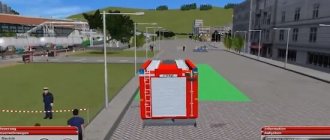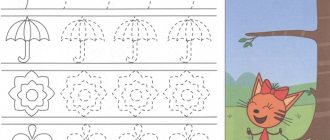Didactic game "Toys"
Dolls have existed for centuries; they are the best means of comprehensive development and socialization of children. Therefore, no kindergarten can do without a large play corner.
The purpose of the didactic game “Toys” is to get acquainted with different dolls and toys, to develop the ability to distinguish between them based on their main characteristics.
Tasks:
- formation of ideas about the types of toys, their size, geometric shape, color, number;
- enrichment of vocabulary on the topic “Children’s toys”;
- education of careful handling of toy objects;
- developing the ability to think logically and concentrate;
- improvement of finger motor skills, general coordination of movements, spatial orientation;
- development of speech skills, the ability to communicate, build a dialogue, listen to the interlocutor, answer questions, describe objects;
- development of imagination, visual perception.
Speech game with toys 2. “Teams”
We teach the child to use verbs in the imperative mood in speech. We prevent and correct grammatical errors in children's speech.
Tanya and Vanya's toys love to follow their commands. Let's teach your toys to perform different commands.
Ask your child to choose a favorite toy to teach. The toy (in the hands of an adult) carries out the baby’s command only if he has not made a grammatical error. In case of an error, the toy “wait” for the child to correct his mistake himself or with the help of adults.
First, you help the child give commands to the toy: “Ask the doll to dance, lie on its back, sing, etc.”, then the child comes up with the commands, and you only help him, suggest the correct option if necessary. In the future, you can change roles with the child.
Below I give a selection of words that children very often make mistakes and say, for example, like this: “lie down”, “wave”, “sing”, “wake up”. These mistakes will very quickly disappear from children’s speech after our fun game. The main thing is to repeat the game many times with different toys and different teams. Commands can be made by an adult, a father and mother, or a child at your request - come up with your own options! Have fun playing!
Sample commands for playing with a toy: sit down, bend over, wave your hand, sing, dance, draw, run, jump, sleep, wake up, clap your hands, stomp, lie on your back, lie on your tummy, comb your hair, ride, sit, jump over ..., touch your nose (ears, tail, mouth), etc.
The importance of didactic games and toys in the education of young children
Educational games and educational toys are of great importance in the learning, learning and development of young children. After all, it is a game and a toy that can simultaneously teach, educate and bring joy to a child.
From an early age, a child actively learns about the world around him, through studying what is happening around him. In this knowledge, he is actively helped by educational games and toys, which help expand the child’s horizons, teach him to observe and highlight the characteristic features of objects, and establish simple relationships between them.
Too lazy to read?
specialists and get an answer in 15 minutes!
Ask a question
Educational games and toys are of particular importance in the education of young children, since with their help children learn and assimilate the norms and rules of behavior in society and acquire skills of interaction with others. All these skills are necessary for children not only for successful subsequent studies at school, but also for successful socialization in society.
Observation 1
A didactic game and a toy are inseparable from each other. Thus, an educational toy can become the beginning of a game during which a storyline unfolds that requires additional toys.
The value of educational games and toys is that they introduce children to life, promote their mental development and provide opportunities for all types of children's activities.
Speech game on the topic “Toys” 4. “How we play”
We learn to select actions (verbs) to an object (noun).
Tanya and Vanya love to play with toys. And they want to know how you play with your toys. Let's tell them about our games (you can use a toy phone). You “dial a number” on a toy phone and start a conversation: “Hello, Tanya and Vanya! This is Danilka calling you. How are you? We are playing, do you want to know how? Now Danilka and I will tell you”:
Danilka (your child’s name), what are we doing with the ball? We roll, throw, catch (we choose words together with the baby). If a child wants to show how he does it, let him show all the actions right there. During the demonstration of actions, he can remember new actions and name them too, or he can come up with them.
- What does the ball do? Rolls, flies, bounces, bursts, jumps, jumps, hits the floor, etc.
- What do we do with the doll? We put the doll to bed, feed, drink, dress, undress the doll, rock it, and take it for a walk.
- What does the doll do? Walks, eats, sings songs, dresses, walks, dresses up, plays, dances.
- What do we do with the car? How do we play with it? We drive, load bricks into the back, honk the horn, catch up with other cars, stop, brake.
- What does the machine do? It drives, rushes, stops, accelerates, skids, drives into a garage, brakes, rolls over, breaks down, gets stuck, drives out, overtakes other cars.
For this game you can choose any toys that your child loves.
Integrated lesson in the senior group on the topic “Toys”
Summary of an integrated lesson
in the senior group on the topic “Toys”
Purpose :
Clarification, expansion and activation of
children's
.
Tasks:
Correctional – educational:
children's vocabulary
in the words of the thematic
group “ Toys ”
;
- improve the grammatical structure of speech
: to develop the skill of forming and using diminutive forms of nouns, using nouns in R. p., units. h.;
— continue learning to answer questions in complete sentences.
Corrective and developmental
:
- create conditions for the use of new words in your own speech;
- develop speech breathing;
- develop fine and gross motor skills, a sense of rhythm, coordination of speech with movements;
- develop intelligence, attention, memory, speech hearing.
- develop the ability to work at a certain pace;
Correctional and educational:
- cultivate interest and attention to the word, one’s own speech and the speech of others.
- to form goodwill, independence, activity.
Equipment:
toys
(horse, boat, ball, bear, bunny, locomotive, car, etc.)
. Pictures of toys.
Progress of the lesson:
The teacher invites the children to go to the table on which there is a letter.
Educator: Guys, look, someone sent us a letter. The letter is from Masha. She writes that all her toys were hidden by the wolves. And she is very sad without them. And in this letter there are tasks from the wolves that we must complete in order to return the toys to Masha. Guys, let's help Masha find her toys?
Children: ( children's answer
).
Guys, in order to successfully complete the tasks, you and I need to stretch our fingers.
Finger gymnastics “Toys”
(Work on the tempo and rhythm of speech.)
On a large sofa in a row ( They alternately clap their hands and bang their fists.)
The Car dolls are sitting: Two bears, Pinocchio, (
Bend all their fingers in turn.)
And cheerful Cipollino, And a kitten, and a baby elephant.
One, two, three, four, five, (Bend their fingers alternately.)
We help our Masha
(Alternately clap our hands and knock with our fists.)
We count the toys.
Educator: Guys, in order to find us Toy Cars we need to complete the tasks sent by the wolves. Let's open the first task.
Game “Name it kindly”:
Doll - doll;
Hare - bunny; and so on.
Well done, you completed this task.
Next task:
Game "What has changed?"
The toys are in a certain sequence and the teacher invites the children to look carefully and remember how they stand. Children close their eyes, the teacher changes places of the toys.
The game "What's missing?"
The teacher removes one toy and asks the children to name the object that was removed. Well done, you are doing well.







